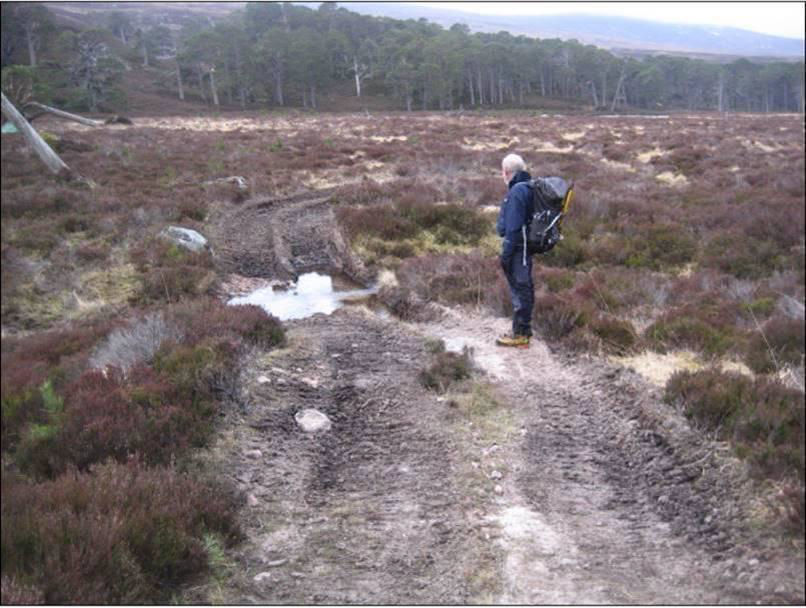
Dave Windle
During June, three of us went up to Mar Lodge to discuss the problem of ATVs damaging the vegetation and the soils, particularly near paths around Derry Lodge. We had received complaints from members and wanted to hear National Trust of Scotland's side of the story. The photos below show typical damage, although are probably not the worst examples.
 |
| Mar Lodge estate ©Ken Thomson |
We met with NTS Property Manager, David Frew, and Ecologist, Shaila Rao, who agreed with us that the tracks were an unsightly mess. The problem is due to the need to remove deer carcasses from the hill once they have been shot as part of the ongoing cull to reduce deer numbers across much of the estate. We can all agree that the reduction in deer numbers achieved so far has led to some spectacular regeneration of the native conifers. However, a lot of deer carcasses are having to be removed; 600 last year and 900 the year before. Given immigration from neighbouring estates, this level of effort is likely to continue into the foreseeable future. Most of this culling is done in late autumn and early winter, when daylight hours are short and plentiful rain makes the ground soggy (and easily damaged).
 |
| Mar Lodge estate ©Ken Thomson |
We talked about two main approaches; using ATVs more sensitively as described above and alternatives to using ATVs. The ongoing work on using ATVs more sensitively has been described above. The discussion on alternatives found no obvious answers. We all agreed that stalkers dragging out carcasses to the nearest track, as done elsewhere, was simply not viable for this quantity of carcasses. NTS explained that, although other estates use ponies, this wouldn¡¦t work at the very low deer densities now found on the Mar Lodge Estate, where the probable location of the carcass was very difficult to predict (and hence getting the pony into a suitable position, ready to remove the carcass difficult to achieve). If any reader knows of examples where ponies are used at very low deer densities, we would be pleased to hear.
We discussed the option of leaving more carcasses on the hill, particularly those requiring an ATV to travel across boggy ground. NTS stated that they wouldn't do this for "PR" reasons.
SNH, the government adviser, are aware of the problem and favour "light engineering works", such as matting across boggy ground and simple bridges to enable ATVs to cross burns without destroying the banks. We are not yet convinced that this is the solution. Although NTS had no clear ideas on the way forward, they fully agreed that change was needed; possibly putting in the sort of "light engineering works" suggested by SNH, coupled with reinstating some of the main access tracks removed in the past. It will be very interesting to see how these ideas develop.
After the meeting, Ken Thomson did some research on the option of leaving some carcasses on the hill and came up with the following.
The sight of a deer carcass lying on the ground may provoke varying types and degrees of interest. Some may assume accidental death, such as falling down a cliff or being washed away by a spate, while others may blame under-nutrition due to a harsh winter and/or over-stocking. In 2010, concerns were raised that hillwalkers would accuse the estates, rather than nature, of being responsible - although, of course, excessive deer densities in the first place would account for many such sightings. It is worth noting that the high number of calf deaths is unlikely to be noticed by hillwalkers, since these will mostly occur in secluded areas, and be quickly removed by predators and scavengers.
There are practical and ethical arguments for ensuring that shot carcasses are removed, used for venison, and not "wasted". Estates tend to remove most or all carcasses, both for the venison and to avoid confrontation with neighbours and visitors such as hillwalkers, thereby denying natural carrion-seekers, such as eagles, ravens, crows, foxes, pine martins, badgers, otters and mink, not to mention smaller invertebrate beneficiaries such as beetles and blowflies, and underground effects on vegetation and soil nutrition. Minerals such as calcium can be difficult to come by, and bones (as well as discarded deer antlers) are a valuable part of the ecosystem.
According to the James Hutton Institute, there is increasing interest in leaving some carcasses on the hill because:
They looked at this in 2013 and concluded that "expecting carcasses to simply be 'good for biodiversity' may be too naive a view".
Most estates will go to some lengths to extract the carcasses, both to avoid any bad PR due to the appearance of too many rotting corpses and also because they are a valuable source of income.
Please let the webmaster know if there are problems with viewing these pages or with the links they contain.